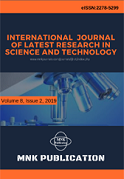DOI:10.29111/ijlrst ISRA Impact Factor:3.35, Peer-reviewed, Open-access Journal
Research Paper Open Access
International Journal of Latest Research in Science and Technology Vol.4 Issue 3, pp 23-27,Year 2015
Correspondence should be addressed to :
Received : 03 June 2015; Accepted : 16 June 2015 ; Published : 30 June 2015

| Download | 125 |
|---|---|
| View | 180 |
| Article No. | 10520 |
Background: Depression and elderly type 2 diabetes mellitus often coexist but poorly studied. This study evaluates depressive symptoms and the associated risk factors among elderly type 2 diabetes mellitus patients at selected primary care clinics in rural Perak, Malaysia.Method:Face-to-face interview was conducted to collate socio-demographic data and medical history among participants. The validated Malay version of the Hospital Anxiety and Depression scale (HADS) questionnaire was used to assess anxiety and depression symptoms. The cognitive impairment was assessed using the Elderly Cognitive Assessment Questionnaire (ECAQ) to screen for cognitive impairment among elderly. Result: 510 eligible elderly diabetic patients were screened and 464 consented to participate. Majority of participants were females (58.4%), Malays (64.2%), married (82.3%), had primary education (42.5%) and non-smokers (70%). Their mean age was 59.7 ± 10.2 years. Medical history revealed that hypertension, being either obese or overweight, hypercholesterolemia and having stroke accounted for 76%, 65.9%, 42.7% and 6.3% respectively. The prevalence of depressive symptoms was 15.7% (95% CI 12.4, 19.1). Majority of participants (81.1%) had HbA1c level of 6.5% and above. Using chi-square test, significant associations were found between depression and age 60 years and above (p<0.05), unemployment (p=0.033), smokers (p=0.018), cognitive impairment (p=0.04), anxiety symptoms (p<0.001) and underweight (p< 0.038). Conclusion: Depression continues to be a public mental health issue. Its early recognition and prompt treatment are crucial particularly in minority group, unemployed individuals, smokers, cognitive impaired subjects, anxious as well as underweight individuals
Copyright © 2015 F Ariff et al. This is an open access article distributed under the Creative Commons Attribution 4.0 International (CC BY 4.0) license which permits unrestricted use, distribution, and reproduction in any medium, provided the original work is properly cited.
F Ariff, Suthahar A, Saw JA , " Depression Among Elderly Type-2 Diabetics In A Rural Community ", International Journal of Latest Research in Science and Technology . Vol. 4, Issue 3, pp 23-27 , 2015

MNK Publication was founded in 2012 to upholder revolutionary ideas that would advance the research and practice of business and management. Today, we comply with to advance fresh thinking in latest scientific fields where we think we can make a real difference and growth now also including medical and social care, education,management and engineering.

We offers several opportunities for partnership and tie-up with individual, corporate and organizational level. We are working on the open access platform. Editors, authors, readers, librarians and conference organizer can work together. We are giving open opportunities to all. Our team is always willing to work and collaborate to promote open access publication.

Our Journals provide one of the strongest International open access platform for research communities. Our conference proceeding services provide conference organizers a privileged platform for publishing extended conference papers as journal publications. It is deliberated to disseminate scientific research and to establish long term International collaborations and partnerships with academic communities and conference organizers.